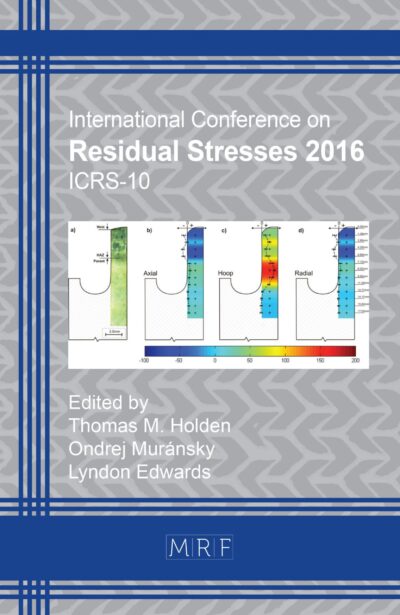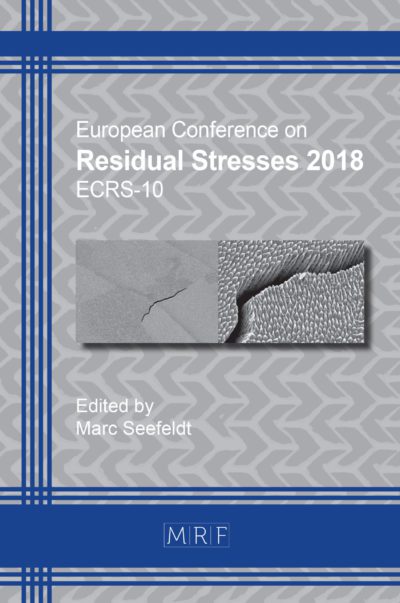Barkhausen noise analysis for inline monitoring of residual stresses using a soft sensor for freeform bending with moveable die
Sophie Charlotte Stebner, Linghao Kong, Viktor Böhm, Ahmed Ismail, Boris Lohmann, Wolfram Volk, Sebastian Münstermann
Abstract. Axial residual stresses, critical to component performance and further processing, are often neglected in the freeform bending process with moveable die. Barkhausen noise analysis offers a non-destructive method for evaluating residual stresses, but signal intensity alone is insufficient due to superimposition of microstructural effects from plastic deformation. This study investigates the relationship between Barkhausen noise measurements and axial residual stresses obtained via X-ray diffraction, using Pearson correlation. Results show that signal symmetry strongly relates to residual stresses. Considering both signal intensity and symmetry poses a promising approach for a quantitative assessment of axial residual stresses during bending.
Keywords
Freeform Bending, Residual Stresses, Barkhausen Noise, Soft Sensor, Smart Monitoring
Published online 5/7/2025, 8 pages
Copyright © 2025 by the author(s)
Published under license by Materials Research Forum LLC., Millersville PA, USA
Citation: Sophie Charlotte Stebner, Linghao Kong, Viktor Böhm, Ahmed Ismail, Boris Lohmann, Wolfram Volk, Sebastian Münstermann, Barkhausen noise analysis for inline monitoring of residual stresses using a soft sensor for freeform bending with moveable die, Materials Research Proceedings, Vol. 54, pp 2012-2019, 2025
DOI: https://doi.org/10.21741/9781644903599-216
The article was published as article 216 of the book Material Forming
![]() Content from this work may be used under the terms of the Creative Commons Attribution 3.0 license. Any further distribution of this work must maintain attribution to the author(s) and the title of the work, journal citation and DOI.
Content from this work may be used under the terms of the Creative Commons Attribution 3.0 license. Any further distribution of this work must maintain attribution to the author(s) and the title of the work, journal citation and DOI.
References
[1] W. Volk, P. Groche, A. Brosius, A. Ghiotti, B.L. Kinsey, M. Liewald, L. Madej, J. Min, J. Yanagimoto, Models and modelling for process limits in metal forming, CIRP Annals 68 (2019) 775–798. https://doi.org/10.1016/j.cirp.2019.05.007
[2] D. Maier, S. Stebner, A. Ismail, M. Dölz, B. Lohmann, S. Münstermann, W. Volk , The influence of freeform bending process parameters on residual stresses for steel tubes, AIME 2 (2021) 100047. https://doi.org/10.1016/j.aime.2021.100047
[3] J. Wu, B. Liang and J. Yang, Trajectory prediction of three-dimensional forming tube based on Kalman filter, Int J Adv Manuf Technol 121 (2022) 5235–5254. https://doi.org/10.1007/s00170-022-09521-5
[4] S.C. Stebner, D. Maier, A. Ismail, S. Balyan, M. Dölz, B. Lohmann, W. Volk, S.Münstermann, A System Identification and Implementation of a Soft Sensor for Freeform Bending, Materials (Basel, Switzerland) 14 (2021) 4549. https://doi.org/10.3390/ma14164549
[5] S.C. Stebner, D. Maier, A. Ismail, M. Dölz, B. Lohman, W. Volk, S. Münstermann, Extension of a Simulation Model of the Freeform Bending Process as Part of a Soft Sensor for a Property Control, KEM 926 (2022) 2137–2145. https://doi.org/10.4028/p-d17700
[6] M. Habschied, B. de Graaff, A. Klumpp, V. Schulze, Fertigung und Eigenspannungen*, HTM J Heat Treat Mater 70 (2015) 111–121
[7] E28 Committee, Test Method for Determining Residual Stresses by the Hole-Drilling Strain-Gage Method, ASTM International, West Conshohocken, PA. https://doi.org/10.1520/E0837-20
[8] E28 Committee, Practice for Estimating the Approximate Residual Circumferential Stress in Straight Thin-walled Tubing, ASTM International, West Conshohocken, PA. https://doi.org/10.1520/E1928-13
[9] C.H. Gur, Review of Residual Stress Measurement by Magnetic Barkhausen Noise Technique, Mater Perform Charac 7 (2018) 504–525. https://doi.org/10.1520/MPC20170080
[10] Deutsches Institut für Normung e.V., Kaltgeformte geschweißte Hohlprofile für den Stahlbau: Teil 1: Allgemeines(10219-1:2016-01), Beuth Verlag GmbH, Berlin, 2016. https://doi.org/10.31030/2399624
[11] Deutsches Institut für Normung e.V., Geschweißte Stahlrohre für Druckbeanspruchungen – Technische Lieferbedingungen: Teil 1: Elektrisch geschweißte und unterpulvergeschweißte Rohre aus unlegierten Stählen mit festgelegten Eigenschaften bei Raumtemperatur 23.040.10; 77.140.75(10217-1), Beuth Verlag GmbH, Berlin, Heidelberg, 2019. https://dx.doi.org/10.31030/2524448
[12] A. Dhar and D.L. Atherton, Influence of magnetizing parameters on the magnetic Barkhausen noise, IEEE Trans. Magn. 28 (1992) 3363–3366. http://dx.doi.org/10.1109/20.179811
[13] B.D. Cullity and C.D. Graham, Introduction to Magnetic Materials, Wiley, 2008. https://doi.org/10.1002/9780470386323
[14] Deutsches Institut für Normung e.V., Zerstörungsfreie Prüfung: Röntgendiffraktometrisches Prüfverfahren zur Ermittlung der Eigenspannungen(15305:2008), Beuth Verlag GmbH, Berlin. https://doi.org/10.31030/1425472
[15] S.C. Stebner, D. Maier, A. Ismail, M. Dölz, B. Lohman, W. Volk, S. Münstermann, Sensitivity Analysis of Barkhausen Noise Measurements for Residual Stress Correlation, in: SMSI 2023, pp. 199–200. https://doi.org/10.5162/SMSI2023/D1.2
[16] X. Kleber and A. Vincent, On the role of residual internal stresses and dislocations on Barkhausen noise in plastically deformed steel, NDT & E International 37 (2004) 439–445. https://doi.org/10.1016/j.ndteint.2003.11.008













